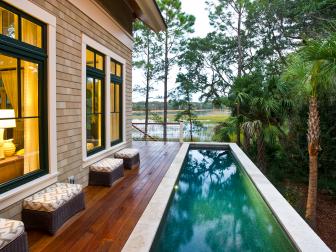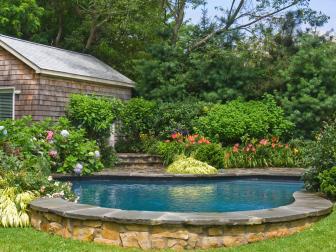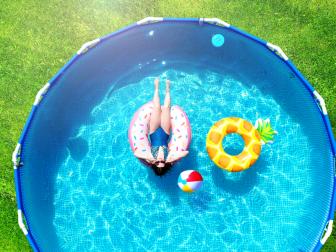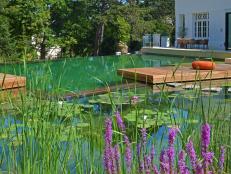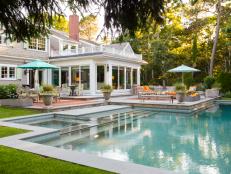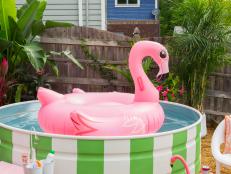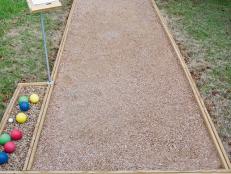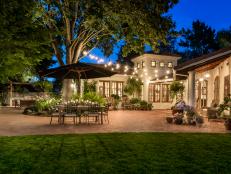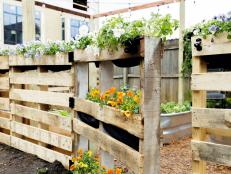How Much Does a Plunge Pool Cost in 2024?
If you’d like to build a pool in your yard but lack the space or budget for a full-size model, a plunge pool might be the perfect solution.
Plunge pools (aka cocktail pools) have smaller dimensions that make them ideal for space-challenged yards or for homeowners who want room left over for other yard features such as an outdoor kitchen or garden. From installation to maintenance costs, plunge pools are also more affordable than full-size pools. There are many factors that can affect the cost of a plunge pool, including materials, size and amenities.
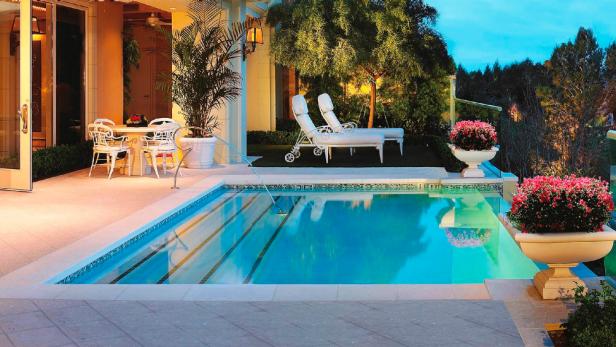
Bradford Products
A petite infinity pool with tile inlay around the rim creates an atmosphere of understated elegance.
In This Article
What is a Plunge Pool?
Plunge pools cater to homeowners who want the benefits of a pool but don’t necessarily need a full-size option. Plunge pools are available in various sizes and shapes, but the average dimensions are 6 to 12 feet wide by 10 to 20 feet long, with a depth of 4 to 8 feet. Just like traditional pools, plunge pools can be saltwater or chlorinated. They also use the same filters as traditional pools and require similar maintenance routines.
What Are Plunge Pools Good For?
You may not be able to do cannonballs or swim laps in a plunge pool, but they are perfect for taking a cool, relaxing dip on a hot day and can accommodate a small group of people for lounging purposes. Some people use plunge pools for low-impact water exercise or full-body submersion therapy for muscle recovery. If you invest in a swim jet, you can get a workout by swimming against a simulated current.
Plunge and Cocktail Pool Design Ideas 52 Photos
You don’t need a huge backyard to have an amazing swimming pool. Take a look at these 51 small plunge pools and cocktail pools that are perfect for a leisurely summer dip.
Can a Plunge Pool be Used as a Hot Tub?
Depending on the size of your plunge pool, it can also double as a hot tub if you choose to heat it. This allows you to use the pool year-round. “Customers heat their water to steamy temps in the winter and keep them cool in the summer,” says Karen Larson, co-founder of Soake Pools, which specializes in plunge pools. Keep in mind that heating the pool will increase utility costs.
How Does Material Affect Price?
Materials are one of the major factors that will determine the cost of your plunge pool. Plunge pools are available in the same variety of materials as full-size pools. Concrete offers the widest range of customization options and is also extremely durable compared to other pool materials, with a lifespan of up to 50 years or longer. However, concrete is the most expensive type of pool to install. It also has a porous quality that makes it vulnerable to cracking and algae growth over time, so you’ll want to factor this into your long-term maintenance budget. Concrete plunge pools average around $40,000 to $90,000 for the unit and installation but can range much higher with added amenities and customized features.
Vinyl and fiberglass plunge pools are generally cheaper than concrete. They don’t come in as many shapes or customizable sizes, but they are easier and cheaper to install. Both are non-porous materials and develop less algae growth than concrete, so they are easier to maintain over time. That said, keep in mind vinyl liner is less durable than concrete and will need to be replaced every 5 to 10 years or so. Fiberglass and vinyl plunge pools typically cost $20,000 to $40,000, with smaller, above-ground pools at the lower end of this range.
If you’re looking for an extremely low-budget alternative, Allison Messner, CEO and co-founder of online landscaping design company Yardzen, suggests checking out a stock tank pool design or even a round cedar tub. Trendy stock tank pools can run as low as around $1,000, though this does not include costs like sealer, a filtration system, heating and additional features. Stock tank pools They are made of galvanized steel with a farmhouse aesthetic, while cedar tubs have more of a rustic charm. You can place these on decks, yards or even rooftops at a fraction of the cost of a concrete, vinyl or fiberglass plunge pool.
10 Splashy Stock Tank Pool Ideas to Copy This Summer 22 Photos
Stock tank pools are a budget-friendly, space-saving alternative to standard backyard swimming pools. Check out these DIY ways to make your stock tank pool your favorite summer destination.
Are Plunge Pools Above-Ground or In-Ground?
Plunge pools can be built in-ground, above-ground or partially in-ground. In-ground options are generally the most expensive. For in-ground plunge pools, you must hire contractors to excavate a hole in the ground and install the pool. Excavation costs vary depending on the difficulty of the site. If trees, outbuildings or landscaping make the site less accessible, the cost will likely be higher. You may also pay more if the excavation company digs up trees, stumps or large boulders. Above-ground pools are cheaper, in part because they don’t require excavation. If above-ground pools are not an option, you can opt for a partially in-ground pool. You will still need to pay for some excavation but the cost will be less than a fully in-ground pool.
In-Ground vs. Above-Ground Pools: Pros + Cons of Each
Budget, surroundings and resale value are just a few factors that you need to consider when deciding what type of pool to install in your backyard. Compare in-ground and above-ground pools to see which one if right for you.
Do Plunge Pools Require Permits?
Yes, as with full-size pools, plunge pools require permitting for construction, excavation and possibly for electrical work. These steps ensure the installation work is performed safely and up to code. Check with your local municipality to determine which permits are required and how much they will cost. Permitting costs vary widely between municipalities, ranging from $1,000 to $2,000 in utilities permits for a prefab plunge pool to $2,000 to $3,000 for a customized plunge pool.
Maintenance Costs for Plunge Pools
Maintenance routines for plunge pools are the same as they are for traditional pools. Whether you clean it yourself or hire a professional, you will need to maintain chemical balance, test pH levels, clear debris and run filters. You must purchase the necessary chemicals and may need to winterize your pool to avoid damage to your filter or pump and to minimize cracks and algae growth.
While these costs can add up, the smaller footprint of a plunge pool means that you’ll spend less time and money on maintenance than you would with a full-size pool. “Maintaining a plunge pool is just like any other pool except the smaller body of water tends to be easier to maintain since there is less of it,” says Larson. In addition to needing smaller amounts of cleaning chemicals, you won’t require as much energy to power parts such as pumps. For example, heated pools can drive up utility bills due to the amount of energy required to heat the water. Plunge pools cost less to heat than full-size pools because there is less water to heat up. The smaller size also means there is less water from which to clean debris.
Messner points out that plunge pools are also a good option if you live in an area that limits pool size due to water conservation. Plunge pools use less water than full-size pools while still offering the refreshing experience of dipping into cool water.
Must-Do Swimming Pool Cleaning and Maintenance Tasks (and How Often You Should Do Them)
Keeping a regular cleaning and maintenance schedule will help you work less and enjoy your pool more.
Plunge Pool Features and Amenities
Plunge pools may be smaller in size, but you can still upgrade them with any number of amenities. Baja shelves or tanning ledges are popular in plunge pools. These allow you to enjoy the cooling benefits of water without fully submerging yourself in the pool. You can also design benches in the pool and stairs for easy access. These customizations will increase your final cost due to additional materials and labor.
As with full-size pools, you can invest in lighting, landscaping and water features to boost visual appeal. Additional materials like rock walls will increase costs, and you may need to pay for electrical upgrades to power these features. You can also get creative with pool tiles. “Another fun and vibrant trend that we often see with plunge pools is adding custom water line tile,” says Messner. Picking stylish tiles to peek out along the water line is an easy way to make a style statement with your plunge pool.
Some pool owners install resistance jets, whether it’s for massage therapy or for low-impact performance training. Swim jets range anywhere from $2,000 to well over $6,000, so these will drive up the final cost of your plunge pool.
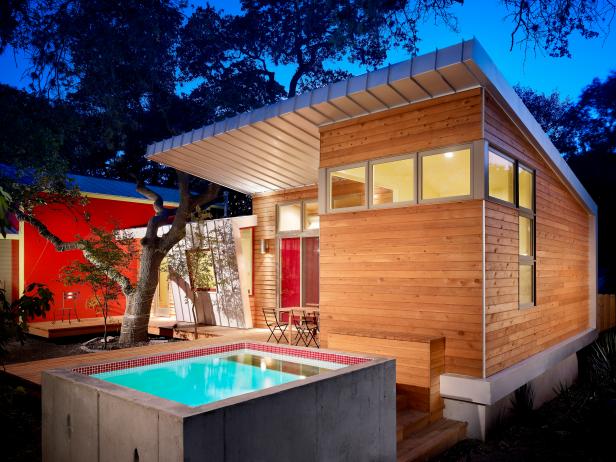
Casey Dunn, Clayton and Little Architects
A stained cedar theme with a lively color palette transforms this remodeled home in Austin, Texas into a work of art that is further enhanced by a private backyard deck with a showstopping plunge pool of concrete and tile.
Plunge Pool Trends
Wellness yards are a plunge pool trend that have recently gained in popularity. “There’s a renewed focus on self-care and wellness in our personal outdoor spaces,” says Messner. “Along with a plunge pool, homeowners are installing additional elements like an adjacent cedar or infrared sauna, cold plunge tub daybeds or a multi-purpose yoga and exercise deck.”
Other plunge pool trends are decks installed around above-ground plunge pools. This combines the lower cost of an above-ground plunge pool with the in-ground look of a surrounding deck. Larson says many homeowners have also been installing two plunge pools next to each other, such as a 7’x7’ square pool next to a 7’x13’ rectangular pool. “The intention is to keep them running at the same time but at two different temperatures,” says Larson. Owners can alternate between a cold-water plunge and a hot tub immersion.
Saltwater vs Chlorine Pools: Which One Is Right for You?
Saltwater and chlorine systems are two of the most common pool sanitization systems. Learn about the pros and cons of each system and find some new alternatives to each.








